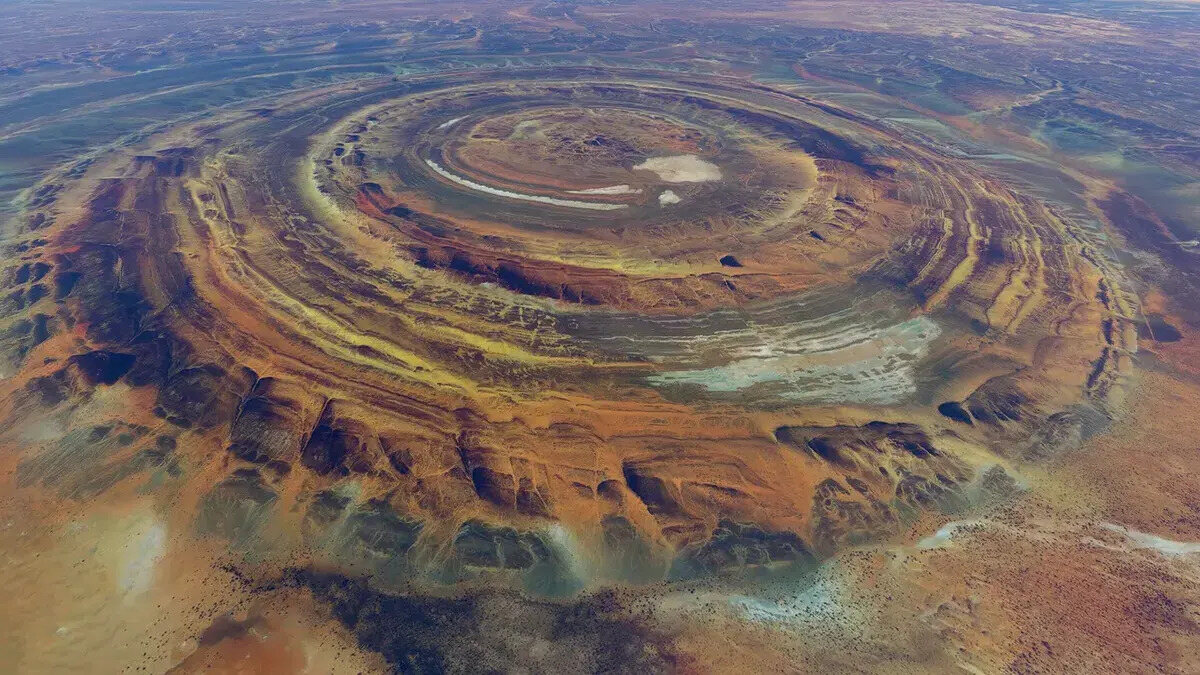Mystery Of The Hidden Eye In The Sahara

Have you ever heard of the Eye of the Sahara? This natural wonder, also known as the Richat Structure, lies in the heart of the Sahara Desert in Mauritania. From space, it looks like a giant bullseye, with concentric rings spanning nearly 30 miles in diameter. Scientists once thought it was an impact crater from a meteor, but now believe it formed from volcanic activity and erosion over millions of years. Despite its remote location, adventurers and researchers find it fascinating. Imagine standing at the center of this geological marvel, surrounded by layers of Earth's history. Intrigued yet? Let's dive deeper into this mysterious formation.
What is the Hidden Eye in the Sahara?
The Hidden Eye in the Sahara, also known as the Richat Structure, is a geological formation in Mauritania. This mysterious landmark has puzzled scientists and travelers alike. Its circular shape, visible from space, has sparked many theories about its origin.
How Was the Hidden Eye Formed?
Understanding the formation of the Hidden Eye involves delving into geological history. Some believe it was created by a meteor impact, while others argue it resulted from volcanic activity. Here are some key points about its formation:
- Geological Uplift: The structure may have formed due to the uplift of rock layers, creating a dome-like shape.
- Erosion: Over millions of years, wind and water erosion sculpted the circular patterns seen today.
- Volcanic Activity: Some scientists suggest volcanic activity played a role in shaping the structure.
- Meteor Impact: Another theory posits that a meteor impact caused the initial formation, later modified by erosion.
Why is the Hidden Eye Important?
The Hidden Eye holds significant scientific and cultural value. Its unique features provide insights into Earth's geological processes. Here’s why it matters:
- Geological Research: Studying the structure helps scientists understand similar formations on Earth and other planets.
- Cultural Significance: Local legends and myths surround the Hidden Eye, adding to its mystique.
- Tourism: The site attracts adventurers and researchers, boosting local tourism.
- Environmental Studies: Examining the area contributes to broader environmental and climate studies.
How to Visit the Hidden Eye in the Sahara?
Visiting the Hidden Eye requires careful planning due to its remote location. Here’s how you can make the journey:
- Travel to Mauritania: Start by flying into Nouakchott, the capital of Mauritania.
- Local Guides: Hire local guides familiar with the terrain to ensure a safe trip.
- Off-Road Vehicles: Use off-road vehicles to navigate the challenging desert landscape.
- Camping Gear: Bring camping gear and supplies, as accommodations near the site are scarce.
What to Expect When You Get There?
Arriving at the Hidden Eye offers a unique experience. Here’s what you can expect:
- Stunning Views: The circular patterns and vast desert landscape create breathtaking views.
- Quiet Solitude: The remote location provides a peaceful escape from urban life.
- Scientific Exploration: Opportunities to learn about geology and local history abound.
- Photography: Capture stunning photos of the unique geological formation.
Interesting Facts About the Hidden Eye
The Hidden Eye is full of intriguing details. Here are some fascinating facts:
- Astronauts’ Landmark: Astronauts use the structure as a landmark when orbiting Earth.
- Ancient Theories: Some ancient cultures believed the Hidden Eye was a gateway to another world.
- Size: The structure spans approximately 40 kilometers in diameter.
- Discovery: It was first identified by astronauts during the Gemini missions in the 1960s.
What Are the Theories Surrounding the Hidden Eye?
Various theories attempt to explain the Hidden Eye’s origin and significance. Here are a few:
- Atlantis Connection: Some theorists link the structure to the lost city of Atlantis.
- Natural Formation: Most scientists agree it’s a natural geological formation.
- Extraterrestrial Influence: A fringe theory suggests extraterrestrial involvement in its creation.
- Ancient Civilization: Some believe it was created by an ancient, advanced civilization.
How Does the Hidden Eye Compare to Other Geological Formations?
Comparing the Hidden Eye to other formations highlights its uniqueness. Here’s how it stands out:
- Size and Shape: Its size and perfect circular shape are rare among geological formations.
- Visibility from Space: Unlike many formations, the Hidden Eye is easily visible from space.
- Scientific Interest: It attracts more scientific interest due to its mysterious origins.
- Cultural Impact: The myths and legends surrounding it add to its allure.
What Challenges Do Researchers Face?
Researching the Hidden Eye presents several challenges. Here are some obstacles:
- Remote Location: Its remote location makes access difficult.
- Harsh Climate: The Sahara’s extreme temperatures and conditions pose challenges.
- Limited Resources: Lack of nearby facilities and resources complicates research efforts.
- Preservation: Balancing research with preservation of the site is crucial.
How Can You Help Preserve the Hidden Eye?
Preserving the Hidden Eye ensures future generations can appreciate it. Here’s how you can help:
- Responsible Tourism: Follow guidelines to minimize environmental impact.
- Support Local Efforts: Contribute to local preservation initiatives.
- Spread Awareness: Educate others about the importance of preserving the site.
- Volunteer: Participate in conservation projects if possible.
The Enigma Continues
The Hidden Eye in the Sahara remains one of the most intriguing natural formations on Earth. Its mysterious origins and unique structure continue to captivate scientists and adventurers alike. Whether it's a collapsed dome, an impact crater, or something else entirely, the Eye invites endless speculation. Visiting this remote location offers a chance to witness a geological wonder that has puzzled experts for decades. If you're planning a trip, make sure to prepare for the harsh desert conditions and bring plenty of supplies. The journey might be challenging, but the reward of seeing the Eye in person is well worth it. So, pack your bags, grab your camera, and get ready to explore one of the world's most enigmatic sites. The Sahara's Hidden Eye awaits your discovery.

